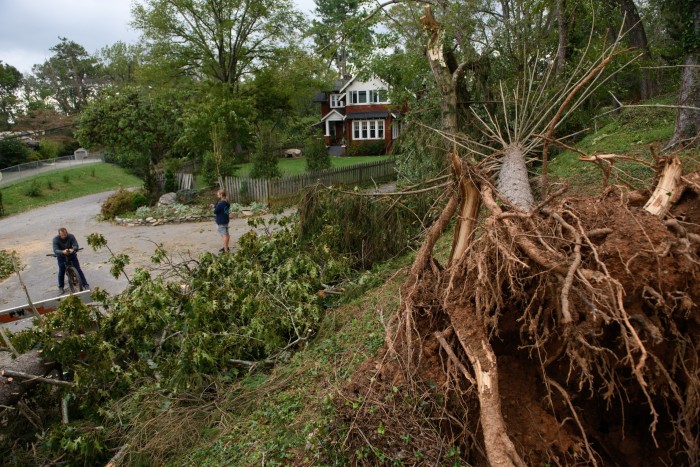
Unlock the US Election Countdown newsletter for free
The stories that matter on money and politics in the race for the White House
Rescuers are still searching for survivors after heavy rain and wind from tropical storm Helene devastated south-eastern US, leaving more than 60 people dead, destroying homes and causing power outages for millions.
Helene tore through Georgia and the Carolinas over the weekend after making landfall as a category 4 hurricane on Thursday, causing widespread flood damage.
The US government’s Federal Emergency Management Agency is co-ordinating a rescue and clean-up effort involving 3,200 personnel across six states where a state of emergency was declared.
As of Sunday morning, at least 64 deaths had been recorded due to the storm across five states, according to the Associated Press. The storm, which has weakened from its peak strength of 140mph winds, is expected to dissipate by Monday.
The worst-hit state was North Carolina, where at least 25 people were killed — the highest death toll from a storm in the state since Hurricane Hugo in 1989 — following the worst flooding in a century.

US President Joe Biden has declared major disasters for North Carolina and Florida, unlocking federal assistance programmes for the affected areas. Biden also approved emergency disaster declarations in Alabama, Georgia, South Carolina and Tennessee, allowing federal resources to begin flowing to those states too.
North Carolina governor Roy Cooper posted on social media platform X on Sunday that the western part of the state “has been hit hard and we are working together rapidly to save lives, surge assistance and begin a difficult recovery”.
The US National Weather Service office in South Carolina said the storm was “the worst event in our office’s history”.
“We are devastated by the horrific flooding and widespread wind damage that was caused by Hurricane Helene across our forecast area,” it added.
Many people were left stranded or without shelter across the region, according to officials. About 2.7mn households were without power throughout the south-east, down 40 per cent from a peak of 4.6mn on Friday, according to the energy department.
The storm could result in up to $34bn in losses from property damage and reduced economic output, according to Moody’s. Forecaster AccuWeather’s preliminary damage estimate was higher at between $95bn and $110bn, suggesting Helene might be one of the most destructive storms in US history.
“If you drew a line from Hilton Head [South Carolina] to Charlotte [North Carolina], everything west of it is pretty well wiped out”, US senator Lindsey Graham of South Carolina told CNN on Sunday.
There were record storm surge levels in the Big Bend area of Florida, with up to 15 feet of storm surge in one county, Fema administrator Deanne Criswell told CBS’s Face the Nation on Sunday. There was flooding and landslides in North Carolina, with search and rescue missions still under way.
This is “historic flooding up in North Carolina, especially [the] western part” of the state, Criswell said.
A “staggering amount of water” brought devastation, with almost 31 inches of rain falling in some parts of North Carolina, said National Weather Service director Ken Graham on Sunday.
Parts of the state were still under flash flood warnings with potential dam failures possible. More thunderstorms were expected in North Carolina, though not anticipated to bring heavy rainfall, Graham added, and the state could expect dry conditions after Tuesday. Flooding could also occur in West Virginia and West Virginia as the system moves north.
More than 2,000 people were in shelters in the south-east, according to Jennifer Pipa, vice-president of disaster response at the American Red Cross.
Criswell said that climate change was leading to much more water damage from hurricanes than in the past, when damage was mainly from wind.
“This storm took a while to develop, but once it did, it developed and intensified very rapidly, and that’s because of the warm waters in the Gulf and so [climate change] creating more storms that are reaching this major category level than we’ve seen in the past”, she said.